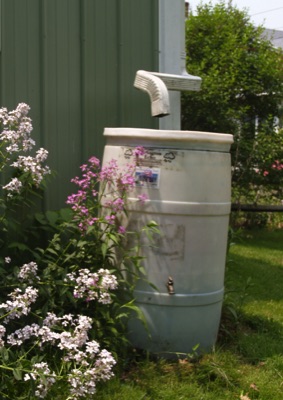Rain gardens are natural or dug shallow depressions formed to capture and soak up stormwater runoff from roofs or other impervious areas such as roads, driveways and sidewalks. They are planted with suitable trees, shrubs, flowers, and other plants, which aid in water penetration, filtration, and the settling and uptake of pollutants. They recharge groundwater, improve water quality, and buffer our waterways.
The first dug rain gardens were created to mimic the water retention characteristics of depressions that occurred naturally before development leveled and compacted the area. Rain gardens for residential use were developed in 1990 in Prince George's County, Maryland, when a developer building a new housing subdivision decided to replace the traditional best management practices (BMP) pond with shallow planted depressions - rain gardens - on each homesite. These gardens proved to be effective in controlling runoff and cheaper to install.
In addition to controlling runoff and improving water quality, rain gardens provide habitat for wildlife and, with the proper selection of plants, increase the number and diversity of birds and butterflies. They provide an attractive and creative alternative to traditional lawn landscapes and require less maintenance, since they do not need to be mowed, fertilized or watered after they are established. When implemented on a community or neighborhood scale, they reduce the load on storm drain systems and flash flooding.
To install a rain garden, survey your lawn during or after a rain. You may find an existing depression which can be developed into your garden or you may dig one in a convenient spot. Sand and compost can be added to improve soil permeability. Plant selection is important; they must be able to tolerate both wet and dry soil conditions. Native plants are preferable since they are most suited to the local soil and rainfall characteristics and are believed to be more beneficial to native birds, butterflies, and other animals.
Make A Rain Garden / Install a Rain Barrel
Photo 1: A rain garden at Georgetown Waterfront Park, a National Park, Washington DC. The Potomac River
and the C&O Canal National Historical Park connect Washington County to the Nation's Capital.
Photo 2: A board member's rain barrel.
For more photographs and information on design and plant selection, see:
Rain Gardens: University Maryland Extension
Other references: Wikipedia-Rain Gardens

By connecting one or more rain barrels to your gutter downspouts you can tap into lower water costs and help your local streams and the Chesapeake Bay at the same time. A rain barrel collects water from your roof and stores it until you need it. Naturally soft water is great for watering that tree you planted earlier this spring, your other garden plants, washing your car, or topping off the swimming pool. It provides a supply of soft water containing no chlorine, lime, calcium or other dissolved salts, making it ideal for washing cars or windows as well as watering trees, gardens and flower pots. Using a rain barrel diverts water from storm drains, decreasing the impact of flooding and erosion.
Together, rain gardens and rain barrels can keep most rainfall on your land, where it will do the most good.
